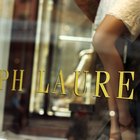There are five different principles of fashion design and four different elements that apply to these principles. The five principles are emphasis, rhythm, unit, balance and scale and proportion. The four different elements are texture, color, line and form. Think of the principles as the directions for fashion and then the elements as the ingredients used to achieve the principle. Each design will incorporate all of these different principles, as it is only through a cohesive usage of all principles and elements that a successful and eye-catching designs are created.
Emphasis and Color
The principle emphasis refers to the part of the design to which the eye is instantly drawn. This emphasis element can be anything. Many times, the element of color is used for emphasis, as contrasting colors in a design produces a lot of emphasis on that item that is contrasting. Color is a very important element as everyone has their own favorite color. Color is also frequently used to express a specific mood.
Rhythm
The rhythm principle refers to using items repeatedly. This can be repeating the same shape in the design, repeating lines or details to form a pattern or repeating colors. Many times, a designer’s complete collection will have a specific rhythm as all the pieces are related in a similar way, such as using the same silhouette or a specific color in all of the designs.
Texture
The element of texture refers to the fabric being used. Fabric will feel a specific texture against the skin. The texture also refers to how a fabric drapes. Using the proper fabric for a design is very important, as different fabrics have different textures and will act in different ways.
Proportion, Scale and Balance
The principle of proportion and scale ties into the balance principle. The proportion of a design is important to achieve balance. A person would look very funny with an oversized head, just as a dress would look odd if it had huge sleeves. These two elements, the head and the sleeves, are out of proportion with the rest of the look. It is important to make all designs to scale so that the proportion of each piece is correct. Proportion also refers to balance as a design can be symmetrical or asymmetrical. Asymmetrical balance can be quite striking, but each piece needs to be properly proportioned or a person will look lopsided.
Lines
The element of the style lines refers to the outline or silhouette of the design. There are many accessories and items that can be used to create different lines. One very well known example of a line is the A-line. The A-line can use belts or fitted waists. From the waist, the skirt flares out creating an "A" shape.
Unity
The principle of unity refers to all elements of the design being in harmony. A design that has unity will have a sense of completeness while one that does not achieve unity will leave the viewer wondering if the design is finished. Many times, accessories can be used to add unit to a design.
Shape and Form
The element of shape and form refers to the visual element of the design. This is one of the first things that a person notices with a design. The form refers to the designs or garments complete shape. The main goal of the shape is to complement or fit a specific body type. The shape and form can emphasize specific areas of the body while downplaying other less desirable areas. The shape tends to change depending on the current trends.
Related Articles

4 Elements of Design

What Is Draping in Fashion?

Custom Made vs. Tailor Made

What Is Verbal Communication?

What Is the Meaning of Judgmental?

Types of Plaids

How to Make Camouflage Clothes

Font Styles for Headstones

How to Dress Feminine, Girly and Womanly

The Difference Between Houndstooth & ...

How to Spot Fake Ralph Lauren Clothes

Factors That Influence Interpersonal ...

What Is a Figaro Style Necklace?

Types of Indian Fabric

Effective Face-to-Face Communication

What Is the Meaning of Colored Bandanas?

How to Change One's Communication Style ...

How to Form a Power Exchange ...

Preppy, Boho and Gothic Fashion Styles ...

Importance of Military Uniform ...
References
Writer Bio
Liz Tomas began writing professionally in 2004. Her work has appeared in the "American Journal of Enology and Viticulture," "BMC Genomics" and "PLoS Biology." She holds a Master of Science in food science from Cornell University and a Bachelor of Science in biochemistry from the University of New Hampshire. She is pursuing her Ph.D. in oenology at Lincoln University.